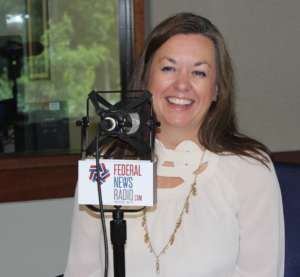

Angela Nordstrom, vice president of federal for NIC, said agencies have a rare opportunity to modernize their systems using a transaction-based approach.
Best listening experience is on Chrome, Firefox or Safari. Subscribe to Views from the Corner Office’s audio interviews on Apple Podcasts or PodcastOne.
Views from the Corner Office is a new show featuring the private sector leaders who influence and impact the federal market. This monthly discussion aims to give insight to federal executives, lawmakers and other industry experts as well as a better understanding into trends, challenges and the evaluation of the technology, acquisition and leadership in the federal market. Hear from the executives who lead the federal practices of government contractors.
Angela Nordstrom, vice president of federal for NIC Inc., sat down with Federal News Radio’s Executive Editor Jason Miller at the station’s studios in Washington, D.C. Here are some excerpts from that discussion.
JM: Is it a good time to be a federal contractor?

AN: It is an exciting time because like you said, when there’s this convergence of leaders both in technology and in government that are coming together and looking at ways that they can do things differently — to me that energy is what we’re seeing in the federal marketplace — that’s percolating everywhere. So our focus has been on that interaction between citizens that are working with their government, businesses that have to work with their government, and their digital experience.
In that marketplace, we’re excited because agencies are asking the right questions. The technology leaders within the contracting officers and the [chief information officers], they’re asking the questions. The business folks are asking the questions and it’s all centered around how can we deliver a better government experience to our end user? When you put technology with that and that willingness and that opportunity to look at things differently and approach things differently — to us, this market is just amazing.
JM: Why is this different today than it has been for the last 20 years? I mean everyone focuses on citizens services, but why is today different from in your view?
AN: To me the difference is because the conversations are happening at the agency level. So when you were talking about some of those experiences and those discussions, I was more focused on the state marketplace at that point and I always say in the states, you have a chief executive officer, the governor who understands and realizes the importance of their daily interaction and delivering services. Because quite honestly, they have to stand up for election every two or four years. That energy is what I’m seeing in agencies today.
And so where you’re seeing this trickledown effect happen is that the secretaries, there’s [talk] about it now. So think about Secretary [Sonny] Perdue at USDA. He’s got, I think, his five point plan of ways that he wants to improve USDA. At the top of that list is customer experience and his top deputies are talking about “we need to make the permitting process easier. We need to make that interaction between who we serve and how we serve better.” So to me that’s where the difference is. It’s not just, the White House is not just OMB talking about it. You’re really seeing that transformation in that conversation happen at the agency level.
JM: Give me a sense of how things have changed for NIC over the last three, five, seven years in terms of how you approach the federal market?
AN: Our delivery model for digital government services has primarily always been, what in the federal space is referred to, as a no cost model or a transaction based model. And let me explain a little bit more about what that means because it is different. Our approach is that for every time that government interacts with an end user, whether it be a citizen or a business or even government itself, there’s a transaction that is occurring there. There’s a passing of information, and there’s a start and an end.
NIC’s approach has been to quantify that so then it can then be measured and that our business model for delivery is based on that. So in practical terms, what that means is that we look for those times where we can bring either greater efficiency or greater service to that end user, and then our business model, our transaction fee or the way that we price the model is based on that transaction.
So instead of the government saying to us, “we want you to build this solution, what’s going to be your end price,” our partnership approach is to think about it as we’re going to be your partner through the life of that contract and the way that our delivery models should be based on is that the transaction between us and them. That’s where the monetary piece should come from.
JM: Sounds to me a little like something called share-in-savings. Is that a model that you’re excited about? Because I think there is some appetite for it.
AN: Yeah, we are. You know share-in-savings is definitely another way to describe this, because in that sense you’re looking at how is the agency gaining efficiency and how are you identifying that up front and how are you making sure that they’re getting that end result that they need. I think that’s what’s exciting about the Modernizing Government Technology Act (MGT) is because that focus is on having the funds up front to deliver a solution, but then creating the payback into the funds and those funds even being available.
JM: What trends are you seeing around the contracting atmosphere as requests for proposals, requests for information are coming out?
AN: NIC’s presence in the federal space has been a pretty short amount of time. We have not gotten onto a lot of very large contract vehicles and when you look at some of those new ones that are coming out and where you’ve got the multiple awards and those types of things. Honestly, we still feel like there’s an old approach to new solutions being presented. So we talked about that transaction approach that we like in delivering digital government services. Just because we see the end results, you can measure that efficiency, you can hold the relationship to being a partnership.
JM: Give me a sense of what’s been so different with DHS. Is it the way they’re writing their RFPs and RFQs or the show me approach?
AN: I really think it’s the show me approach. So most recently I know they’ve got some opportunities that are coming out here in the next quarter where they’ve said, we’re going to do this differently as well. We’re going to have a 10 day turn on their response. What that says is “we don’t need long responses. We don’t need long-winded explanations and so forth. We know the technology is going to change. We know we’re going to take an agile approach.”
They have that confidence as an agency to make those statements and then we’re going to have where you come in and show us what you’re going to deliver or what you’ve delivered in the past. I think that oral presentations, that show me approach, that come in and share with us where you can take us, is just a really great opportunity for agencies to truly hear and see what they’re ultimately going to be purchasing.
JM: What is one thing about you most people don’t know?
AN: [I grew] up in a town of 1,500 folks where we were at the base of Montana. I always like to point out it’s Fort Benton, which is the birthplace of Montana. It was the furthest up the Missouri that Lewis and Clark was able to go. What I always joke with my staff is, I’m not kidding you, but on a daily basis there is a story, an event, an interaction, and it always comes back to Montana. It can be as far-fetched as I mentioned that I grew up in Fort Benton.
I was with Gov. Martin O’Malley when he was the governor of Maryland a few years back. And as you know, he plays the guitar. He was at an event, pulled out his guitar and started singing a song about Thomas Meagher the territorial governor of Montana that just happened to die on a steamboat in Fort Benton, Montana. So — every day something comes back to Montana.
Copyright © 2025 Federal News Network. All rights reserved. This website is not intended for users located within the European Economic Area.
Jason Miller is executive editor of Federal News Network and directs news coverage on the people, policy and programs of the federal government.
Follow @jmillerWFED

